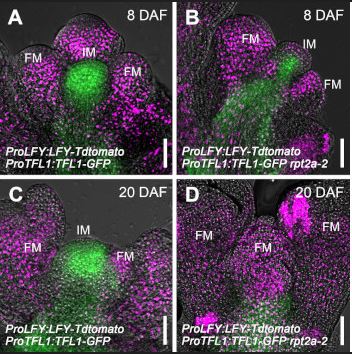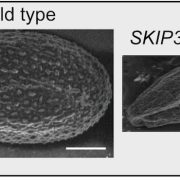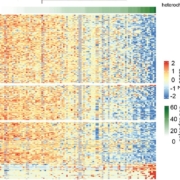RPT2a regulates inflorescence meristem indeterminacy
Yao, Wang et al. identify the mechanisms regulating inflorescence meristem determinacy in Arabidopsis.
https://doi.org/10.1093/plcell/koad249
By Wang Jinsong Yao1, Yi Peng Wang1, Jing Peng1, Pei Pei Yin1, Hengbin Gao1, Li Xu1,
Thomas Laux2, Xian Sheng Zhang1, and Ying Hua Su1
1Shandong Agricultural University.
2University of Freiburg.
Background: While there is a rich diversity of shapes in the plant kingdom, inflorescence architecture can generally be classified into a limited number of types. For example, Brassicaceae members, such as Arabidopsis (Arabidopsis thaliana) or cabbage (Brassica oleracea), exhibit an indeterminate inflorescence architecture, whereas nightshade species, such as tomato (Solanum lycopersicum) or potato (Solanum tuberosum), display determinate inflorescences. These distinct architectures are associated with the indeterminacy of the inflorescence meristem (IM). The precise regulation of TERMINAL FLOWER1 (TFL1) expression is pivotal for governing both the architecture of the inflorescence and the indeterminacy of the IM. However, the mechanisms responsible for controlling TFL1 expression in this context have remained elusive.
Question: What are the mechanisms controlling the activity of the IM identity gene TFL1, thereby specifying the indeterminate nature of the Arabidopsis inflorescence? What is the role of protein degradation in directing inflorescence architecture in Arabidopsis?
 Findings: We present insights into the mechanisms that fine-tune the activity of TFL1, a key regulator of indeterminate inflorescence growth in Arabidopsis. Our findings demonstrate that TFL1 levels in the IM are regulated by DNA methylation mediated by the DNA methyltransferase MET1. Low MET1 levels are maintained through proteolysis via the 26S proteasome subunit RPT2a, which keeps methylation at the TFL1 promoter low, thus promoting IM indeterminacy and indeterminate inflorescence architecture. Conversely, when RPT2a-mediated proteolysis of MET1 is hindered, TFL1 expression levels decrease, leading to a determinate zigzag-shaped inflorescence architecture. Our findings propose an integrative model that explains how proteolytic activity balances the epigenetic regulation of TFL1 expression, ultimately leading to indeterminate inflorescence architecture in Arabidopsis.
Findings: We present insights into the mechanisms that fine-tune the activity of TFL1, a key regulator of indeterminate inflorescence growth in Arabidopsis. Our findings demonstrate that TFL1 levels in the IM are regulated by DNA methylation mediated by the DNA methyltransferase MET1. Low MET1 levels are maintained through proteolysis via the 26S proteasome subunit RPT2a, which keeps methylation at the TFL1 promoter low, thus promoting IM indeterminacy and indeterminate inflorescence architecture. Conversely, when RPT2a-mediated proteolysis of MET1 is hindered, TFL1 expression levels decrease, leading to a determinate zigzag-shaped inflorescence architecture. Our findings propose an integrative model that explains how proteolytic activity balances the epigenetic regulation of TFL1 expression, ultimately leading to indeterminate inflorescence architecture in Arabidopsis.
Next Steps: We plan to explore these diverse models in other plant species, aiming to expand our knowledge regarding the genetic mechanisms governing the wide range of inflorescence architectures observed in nature.
Reference:
Wang Jinsong Yao, Yi Peng Wang, Jing Peng, Pei Pei Yin, Hengbin Gao, Li Xu, Thomas Laux, Xian Sheng Zhang and Ying Hua Su. (2023). RPT2a–MET1 axis regulates TERMINAL FLOWER1 to control inflorescence meristem indeterminacy in Arabidopsis. https://doi.org/10.1093/plcell/koad249







